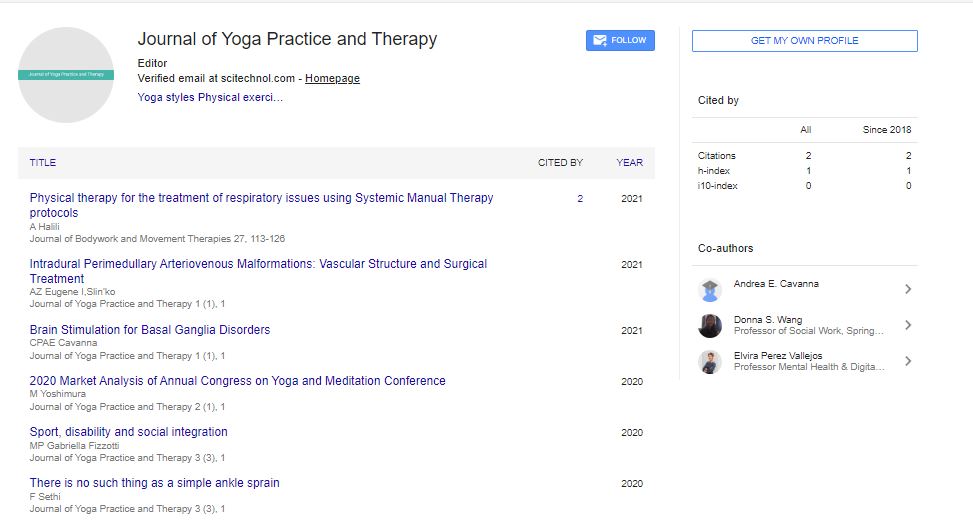Perspective, J Yoga Pract Ther Vol: 6 Issue: 2
Yoga Therapy: The Integration of Yoga in Healing and Wellness
Ishita Gupta*
1Department of Yoga Science, Patanjali University, Haridwar, India
*Corresponding Author: Ishita Gupta,
Department of Yoga Science, Patanjali
University, Haridwar, India
E-mail: ish.gupta@gmail.com
Received date: 29 May, 2023, Manuscript No. JYPTY-23-107044;
Editor assigned date: 31 May, 2023, PreQC No. JYPTY-23-107044 (PQ);
Reviewed date: 14 June, 2023, QC No. JYPTY-23-107044;
Revised date: 21 June, 2023, Manuscript No. JYPTY-23-107044 (R);
Published date: 28 June, 2023, DOI: 10.4172/jypty.1000123
Citation: Gupta I (2023) Yoga Therapy: The Integration of Yoga in Healing and Wellness. Int J Yoga Therap 6:2.
Description
Yoga therapy is a specialized and rapidly growing branch of yoga that focuses on using yogic principles and practices to support healing and promote overall wellness. This therapeutic approach to yoga recognizes the interconnectedness of the mind, body, and spirit and aims to address specific health concerns by tailoring yoga practices to individual needs.
Foundations of yoga therapy
Yoga therapy is grounded in the ancient wisdom and teachings of yoga, which date back thousands of years. However, it distinguishes itself from regular yoga classes by emphasizing the therapeutic potential of yoga for addressing physical, mental, and emotional imbalances.
Certified yoga therapists work collaboratively with clients to develop personalized practices that align with their unique health needs and goals. The focus of yoga therapy is on empowering individuals to take an active role in their healing process, developing a nurturing and supportive environment for personal growth.
Role of asanas (yoga poses)
Asanas, or yoga poses, are central to yoga therapy, just as they are in regular yoga practice. However, in yoga therapy, the emphasis is on selecting poses that are safe and appropriate for the individual's condition and modifying them as needed to suit their abilities.
Yoga therapists use asanas to address physical health concerns, such as chronic pain, joint stiffness, and muscle imbalances. Gentle and restorative poses can be used to alleviate tension and promote relaxation, while more dynamic poses can build strength and improve flexibility.
Pranayama (breath control) in yoga therapy
Pranayama, the practice of breath control, plays a vital role in yoga therapy. Breathing techniques are used to regulate the breath and influence the flow of prana (life force) in the body. Deep and mindful breathing can help calm the nervous system, reduce stress, and promote relaxation.
In yoga therapy, pranayama is employed to address conditions like anxiety, insomnia, and respiratory disorders. Specific breathing exercises, such as alternate nostril breathing and diaphragmatic breathing, are tailored to the individual's needs to support their healing journey.
Power of meditation and mindfulness
Meditation and mindfulness practices are integral components of yoga therapy, offering profound benefits for mental and emotional well-being. Meditation involves observing thoughts and emotions without judgment, cultivating mental clarity and inner peace.
Mindfulness, a key aspect of yoga therapy, encourages individuals to be fully present in each moment, fostering a deeper connection with themselves and their experiences. These practices are particularly effective in managing stress, anxiety, and depression.
Yoga therapy for physical health
Yoga therapy has shown promising results in addressing various physical health conditions, either as a standalone therapy or as a complementary approach to conventional medical treatment. Some areas where yoga therapy has been found to be beneficial include:
Chronic pain: Gentle yoga practices, such as Yin Yoga and restorative poses, can help manage chronic pain conditions like arthritis, fibromyalgia, and lower back pain.
Cardiovascular health: Certain pranayama techniques and yoga postures can assist in managing blood pressure, improving circulation, and reducing stress, thereby supporting heart health.
Respiratory disorders: Breathing exercises and relaxation techniques in yoga therapy can enhance lung capacity and assist individuals with asthma and other respiratory conditions.
Yoga therapy for mental health
Mental health is a vital aspect of overall well-being, and yoga therapy has proven to be a valuable tool in supporting emotional balance and psychological healing. Yoga therapy can be particularly helpful in the following areas:
Anxiety and depression: Mindfulness practices and gentle yoga postures can help reduce symptoms of anxiety and depression, promoting emotional resilience and mental well-being.
Post-Traumatic Stress Disorder (PTSD): Yoga therapy, combined with meditation and relaxation techniques, can assist individuals in coping with trauma and fostering post-traumatic growth.
Sleep disorders: Certain pranayama and meditation practices in yoga therapy can contribute to better sleep quality and improved sleep patterns.
Integration into healthcare
As the evidence of yoga's therapeutic benefits continues to grow, yoga therapy is increasingly recognized in the healthcare field. Many hospitals, clinics, and rehabilitation centers now offer yoga therapy as a complementary treatment alongside conventional medical approaches.
Yoga therapists work collaboratively with healthcare professionals, ensuring that yoga practices are safe and appropriate for individuals with specific medical conditions. This integration into healthcare settings signifies the growing acknowledgment of yoga therapy's potential to enhance overall health and well-being.
Conclusion
Yoga therapy offers a holistic and personalized approach to healing and wellness, focusing on the interconnectedness of the mind, body, and spirit. Through asanas, pranayama, meditation, and mindfulness practices, individuals embark on a transformative journey to selfdiscovery and inner alignment.
The tailored practices in yoga therapy address physical health concerns and support emotional and mental well-being. As individuals embrace yoga therapy as a way of life, they unlock their potential for self-healing, personal growth, and a life of purposeful transformation.
The integration of yoga therapy into healthcare settings signifies the recognition of its therapeutic potential. As more studies continues to validate the effectiveness of yoga therapy, it holds the promise of becoming an essential complementary therapy in promoting holistic health and wellness for individuals of all ages and backgrounds.
 Spanish
Spanish  Chinese
Chinese  Russian
Russian  German
German  French
French  Japanese
Japanese  Portuguese
Portuguese  Hindi
Hindi 